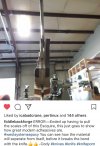This is just my thoughts... Pins became well established in knife making years ago when adhesives were not very good and folks sought mechanical fasteners to hold things together. As we had advances in chemistry and began to better understand polymers and polymerization, we were able to craft better and better resins and catalysts. We figured out how to add UV inhibiters, temperature stabilizers, and gosh knows what else to make the plastic do what we wanted. However, we still cling to the pins. I suspect it's for a few reasons. (1) it makes alignment and assembly much easier and (2) we often don't clean and prepare the surfaces like we should and thus the miracle epoxy never has a chance to grip with it's 4000 pounds per square inch power. So we add a 1/8" rod in the there with say a half inch of length and then we get an additional 785 pounds (3.1415*.125*.5*4000) of epoxy holding strength per pin. Since we never touch the inside of the holes, and the drill leaves a rough surface, we get an easy way to increase the handle bonding strength. (3) it's visually pleasing.
Here's some West g-flex numbers:
http://www.westsystem.com/specialty-epoxies/gflex-epoxy-adhesion-data/


 Sounds like something
Sounds like something